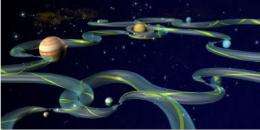September 16, 2009 weblog
Gravitational Space Corridors Could Slash Space Travel Costs (w/ Video)

(PhysOrg.com) -- Scientists studying space travel possibilities have proposed that gravitational space corridors could be used by spacecraft, in much the same way as ships use ocean currents. Taking advantage of gravitational corridors could slash space travel costs.
A computer-generated representation of the gravitational pathways looks like flexible tubes connecting planets and moons in the solar system. The corridors are formed by complex interactions of forces of attraction between the planets and between planets and their moons.
The gravitational corridors connect Lagrange points, which are locations where the gravitational pull of two large bodies exactly cancels the centripetal acceleration needed for a smaller body to rotate with them. Stable Lagrange points are positions at which a light body (such as a spacecraft or satellite) stays motionless with respect to the two larger bodies. Lagrange points, also known as L-points, were used to position the SOHO satellite in a stable, fixed position to observe the Sun.
Scientists in the U.S. and Germany are attempting to map the corridors to allow them to be used by spacecraft exploring the solar system. One of the researchers, Shane D. Ross from the Virginia Polytechnic Institute in the U.S. described the system as a series of low energy corridors that wind between planets and moons. Once a spacecraft entered a corridor it would "fall" along the tube, much as an object falls to Earth.
The only energy required would therefore be to position the spacecraft into the tube. Professor Ross, speaking at the British Science Festival in Guildford, U.K., said the concept is different to the well-known "slingshot" effect that has been used many times in space exploration. This method puts the spacecraft in orbit around a moon, whereas the slingshot technique does not.
The gravitational corridors were used by the Genesis spacecraft, which was launched in 2004. Using the pathways cut the fuel needed by the mission by a factor of ten. The mission aimed to capture samples of particles of solar wind and bring them back to Earth, and partially failed because of a parachute malfunction that resulted in some of the samples becoming contaminated.
Gravitational corridors would be particularly useful for travel between a planet's moons, Professor Ross said. For example, the corridors would allow travel between Jupiter's moons at almost no cost, since the only fuel needed would be for course corrections. The trade-off for the cost savings is time, since it would take months to travel around the system.
The gravitational corridors can slash the cost of interplanetary travel, Professor Ross said, but there will always be a need for some fuel.
More information: Optimal capture trajectories using multiple gravity assists; Stefan Jerga, Oliver Jungea, Shane D. Rossb; Communications in Nonlinear Science and Numerical Simulation, Volume 14, Issue 12, December 2009, Pages 4168-4175; doi: 10.1016/j.cnsns.2008.12.009
Dr. Shane D. Ross page: www.esm.vt.edu/~sdross/
© 2009 PhysOrg.com

















